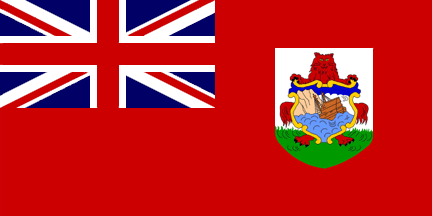
image by Clay Moss, 24 November 2005

Last modified: 2014-05-29 by zoltán horváth
Keywords: bermuda | caribbean | red ensign | lion | wreck | sea venture | bonaventura | somers islands |
Links: FOTW homepage |
search |
disclaimer and copyright |
write us |
mirrors

image by Clay Moss, 24 November 2005
Official Name: Bermuda
Previous name: Somers Islands
Capital: Hamilton
Location: Group of Islands in the North Atlantic
Ocean
Government Type: British Overseas Territory with
Internal Self-Government
Flag adopted: 4
October 1910
Coat of arms adopted: 4 October 1910
ISO Code: BM
See also:
The shade of red on British Union flags and derived ensigns is
a dark red. The Pantone reference is 186. It is slightly
different from "Old Glory" red which is Pantone 185.
Graham Bartram, 13 September 2000
From <www.geocities.com/p_taggett>:
"The national flag of Bermuda is composed of a red
background with the Union Flag (or Jack) in the upper left corner
and the Bermuda coat of arms in the lower fly. From 1910, when
Bermuda received its own Coat of Arms, unofficial versions of the
Union Flag incorporating the Arms appeared in Bermuda. The
present national flag was officially approved in October of
1967."
There is also a picture showing the reverse side of the flag.
Gvido Pētersons, 16 November 2000
What I believe is still the effective Merchant Shipping Act
relating to Bermuda (1988 (Bermuda) Order 1991) confirmed
undefaced Red Ensign as the proper colours for ships.
David Prothero, 12 August 2002
The Bermuda Red Ensign was "established" as a sea
flag in 1915 but have no record of by whom, and this
seems to be in contradiction of the Merchant Shipping (Bermuda)
Order of (from memory) 1991 or thereabouts, which stated (or
perhaps confirmed?) that the undefaced Red Ensign was the proper
colours for ships registered in Bermuda?
I also have it that the defaced Red Ensign was
"authorized" for use on land in 1967 (no date), but
again, no record of who authorized it?
Christopher Southworth, 14 June 2005
19 August 1955 - Colonial Office to Admiralty. Governor of
Bermuda reports; "Despite the fact that no official
recognition appears to have been given to it, Red Ensign with the
arms of the colony in the fly is widely used here, not only on
privately owned vessels but also on private buildings
ashore."
"Records of Colonial Office show no authorisation has been
given for the use of the Red Ensign in this manner, but its
practice is evidently well established and it would probably be
difficult to attempt to discontinue the practice."
Head of Naval Law noted that the only flags authorised for
Bermuda were the defaced Union Flag and Blue Ensign, and Royal
Bermuda Yacht Club. Red Ensign with arms was without
sanction or authority from Admiralty. Admiralty would be unable
to give any authority to regularise this misuse of the flag. It
was therefore for consideration, whether on political grounds the
practice should be allowed to continue without interference, and
if so whether such an attitude was likely to impair in any way,
the Admiralty's control over British flags. It was not
unlikely that similar irregularities were occurring elsewhere.
The Admiralty Archivist was unable to trace any reference to the
origin of the use of the defaced Red Ensign in Bermuda. 14
September 1955 - Head of Military Branch wrote that prohibition
of a long-standing custom could be resented. The
position should be explained and further action left to the
discretion of the Governor. [National Archives (PRO) ADM
1/26283].
David Prothero, 16 June 2005
In the current issue of BR20 (and based on a flag of 60
units x 120 units) the shield is centred on the fly half, is 34
units high x 27 units across with the square being 25 units deep.
Christopher Southworth, 20 November 2005
The protocol manual for the
London 2012 Olympics
(Flags and Anthems Manual
London 2012 [loc12]) provides recommendations
for national flag designs. Each
NOC
was sent an image of the flag, including the
PMS shades, for their approval by LOCOG. Once this was obtained, LOCOG produced
a 60 x 90 cm version of the flag for further approval. So, while these specs may
not be the official, government, version of each flag, they are certainly what
the NOC
believed the flag to be.
For Bermuda: PMS 032 red, 281 blue, process blue, 468 brown, 497 brown, 109
yellow, black, 248 green. The vertical version is simply the flag turned through
90 degrees clockwise.
Ian Sumner, 10 October 2012
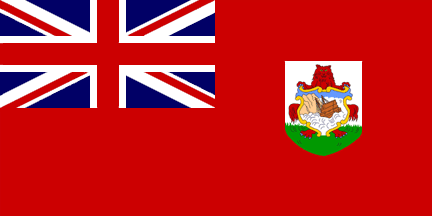
image by Clay Moss, 23 November 2005
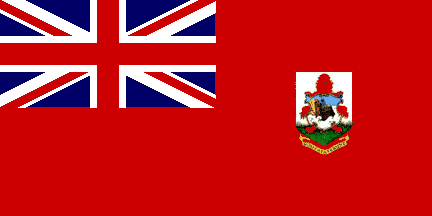
image by Antonio Martins, 1 April 2000
In Graham Bartram's BR 20 change 5 page, the Bermuda's
ensigns, flag and Coat of Arms do not display the motto.
Armand du Payrat , 4 April 2000
The official version does not bear the motto, but this is an
area that you do get variations. I've seen British Virgin Island
flags without the motto, so I suppose its equally likely that
Bermudan flags exist with the motto, but the official design is
sans motto.
Graham Bartram , 4 April 2000
There seems to be some controversy over whether the motto is
used on any Bermuda flag. I can say that I have never seen it,
whether directly on an ensign or in a white disc.
Aidan Stones , 19 May 2000
Foreign civilian ships visiting any British Overseas Territory
should fly, as a courtesy flag, the Territory's own Red Ensign,
if the territory has one and the ship happens to carry one. The
undefaced British Red Ensign is always an acceptable alternative.
If the ship is a Foreign government vessel it should fly the
Territory's Blue Ensign. Foreign warships should fly a British
White Ensign.
Basically the British rule is that you may use either the
appropriate Red, Blue or White ensign (depending upon your own
status) or the land flag, except that you cannot use the Union
Flag at all.
Graham Bartram, 1 April 1999
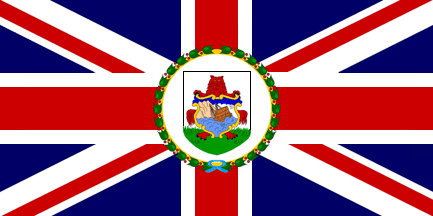
image by Clay Moss, 25 November 2005
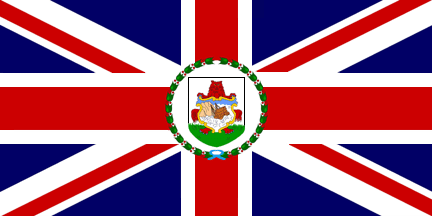
previous (pre-1999) flag
image by Clay Moss, 25 November 2005
In the 1961 edition of H. Gresham Carr's Flags of the World [car61] is the following entry on pages 102 and 103:
BERMUDA uses her Arms. On the Union Flag the shield is placed upon the white circular background, which is surrounded by the garland. On the Blue Ensign there is no wreath or background. The shield is with a green-grassy "mound in base, upon which is seated a red lion "affront?." The lion supports a scrolled shield upon which is a representation of the wreck of the Sea Venture, [...] In passing, it is interesting to note that Bermuda has retained the 1606 pattern Union Flag, i.e. without the St. Patrick's Cross, as a reminder of its great age as a colony.
Which is maddingly non-specific! Does this mean the Union Flag in all contexts? Or only when used as a Union Flag (presumably including in the Governor's Flag) It could, of course, be a piece of spurious information Carr accepted as a fact. It's also interesting to note that Carr does not mention the Bermudian Red Ensign, which is of course now the colony's flag, even though that was instituted in 1915 (according to Crampton's Observer's Book of Flags, 1991, p. 45)
Also whilst on the subject of colonial Red Ensigns, Carr
states (p. 52) that according to the 1894 Merchant Shipping Act
the Red Ensign must be worn undefaced by all British merchant
vessels, including colonial vessels, unless an Admiralty Warrant
has been granted authorising a local Red Ensign.
Roy Stilling, 6 March 1996
Bermuda uses her coat of arms as per all British colonies for
the Governor's standard ie: the badge placed on a white disc
surrounded by a garland in the centre of the Union Flag.
The flag used locally by civilians for both boats and on land is
the defaced red ensign. However, larger vessels registered on the
Bermuda registry of shipping fly the undefaced red ensign as
required by the Admiralty. This flag is also used by the
government on land in conjunction with the Union Flag.
The defaced Blue ensign is used solely by the government marine
services (tugs, ferries, harbour patrol vessels etc.)
During the 1960/70's the official Bermuda flag used the coat of
arms on a white disc on the red ensign, but I have never seen it
like this on the blue ensign.
One or two of these still exist and I am still trying to find one
before they are destroyed through use. I too have heard of the
usage of the 1606 Union Flag, however I have never come across
any evidence of this, although I am still looking and will let
you know if I find out. There are several good books in our local
library, but they have been out of reach due to recent
renovations. Unfortunately, due to our "overextensive"
use of the Union Flag, most old photographs of Bermuda show this
flag only.
Aidan Stones , 4 April 2000
I have recently come across some old Bermuda photographs from
the 1930's and 40's which show the Bermuda flag. I still do not
see any evidence of the pre-1801 union flag being used.
Aidan Stones , 19 May 2000
As I understand it, the gold ring was originally requested by
the Governor of Gibraltar as being part of the arms of that
territory, and it was included into all the others by a sort of
accident.
Christopher Southworth, 29 May 2005
The correct proportions of the Union Flag for use in the field
by the British Army are 3:5, but the correct ratio for all
defaced Red or Blue Ensigns is 1:2 whether for use on land or
sea, and as far as I can discover the occasional use of 3:5.is
either a misunderstanding of the recommendations for other flags
or a commercial/economic decision by flag manufacturers.
Christopher Southworth, 24 November 2005
The flag of Bermuda
College, which is organized on the model of an American
liberal arts college even though Bermuda is actually governed by
the UK, can be seen on a web site belonging to Hamptoin
University in Virginia, a traditionally Afro-American
institution. The Bermuda College flag is at <www.hamptonu.edu>.
More information on Bermuda College at <www.bercol.bm>.
Ron Lahav, 10 August 2006